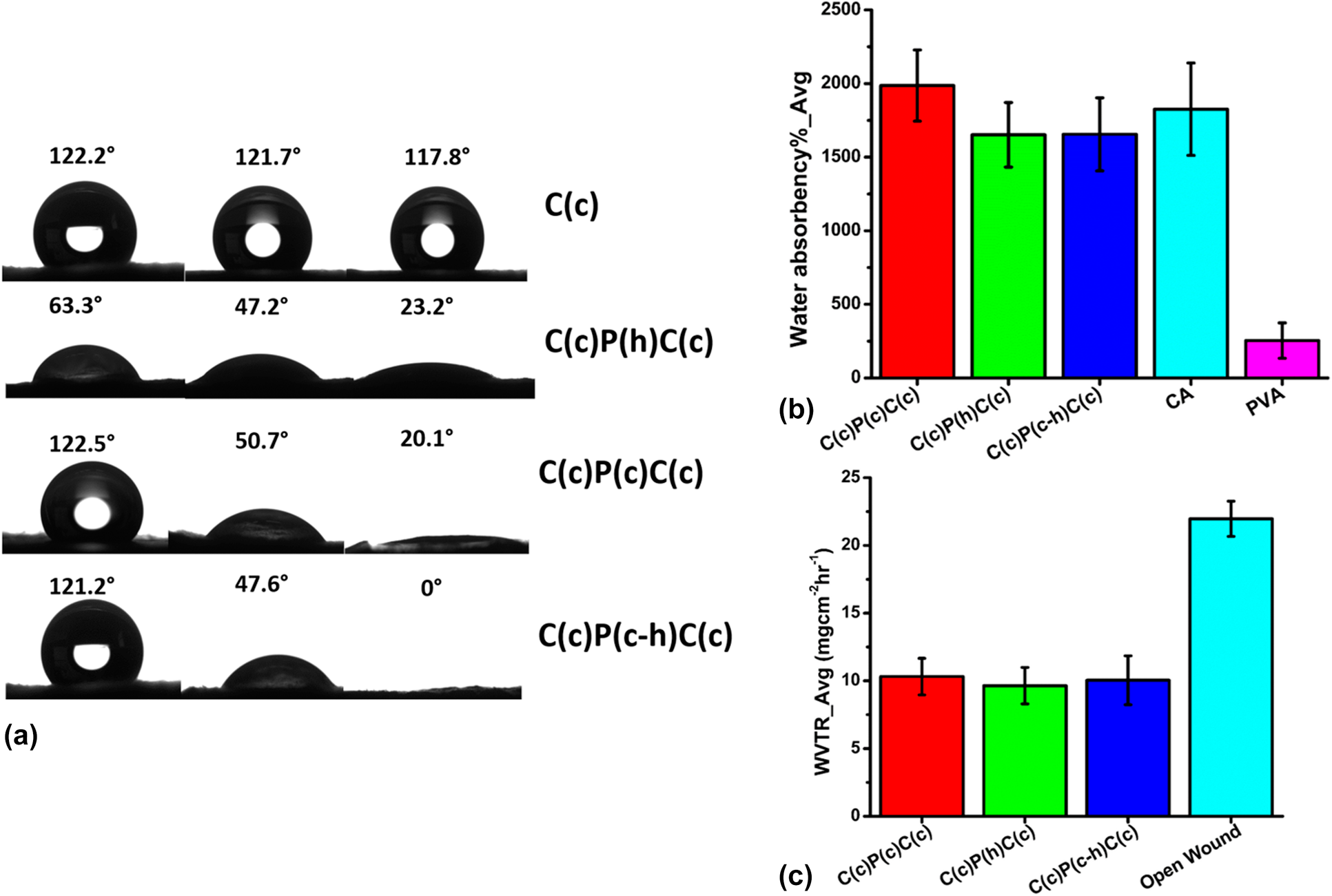Crossref Citations
This article has been cited by the following publications. This list is generated based on data provided by
Crossref.
Samraj.S, Mark David
Kirupha, Selvaraj Dinesh
Elango, Santhini
and
Vadodaria, Ketankumar
2021.
Fabrication of nanofibrous membrane using stingless bee honey and curcumin for wound healing applications.
Journal of Drug Delivery Science and Technology,
Vol. 63,
Issue. ,
p.
102271.
Liang, Wencheng
Jiang, Mingli
Zhang, Junyong
Dou, Xiaoming
Zhou, Yan
Jiang, Yun
Zhao, Li
and
Lang, Meidong
2021.
Novel antibacterial cellulose diacetate-based composite 3D scaffold as potential wound dressing.
Journal of Materials Science & Technology,
Vol. 89,
Issue. ,
p.
225.
Fahimirad, Shohreh
Abtahi, Hamid
Satei, Parastu
Ghaznavi-Rad, Ehsanollah
Moslehi, Mohsen
and
Ganji, Ali
2021.
Wound healing performance of PCL/chitosan based electrospun nanofiber electrosprayed with curcumin loaded chitosan nanoparticles.
Carbohydrate Polymers,
Vol. 259,
Issue. ,
p.
117640.
Gruppuso, Martina
Turco, Gianluca
Marsich, Eleonora
and
Porrelli, Davide
2021.
Polymeric wound dressings, an insight into polysaccharide-based electrospun membranes.
Applied Materials Today,
Vol. 24,
Issue. ,
p.
101148.
Ghiasi, Yeganeh
Davodiroknabadi, Abolfazl
and
Zohoori, Salar
2021.
Electrospinning of wheat bran cellulose/TiO2/ZnO nanofibre and investigating the UV blocking and bactericidal properties.
Bulletin of Materials Science,
Vol. 44,
Issue. 2,
Abazari, Mohammad Foad
Gholizadeh, Shayan
Karizi, Shohreh Zare
Birgani, Nazanin Hajati
Abazari, Danya
Paknia, Simin
Derakhshankhah, Hossein
Allahyari, Zahra
Amini, Seyed Mohammad
Hamidi, Masoud
and
Delattre, Cedric
2021.
Recent Advances in Cellulose-Based Structures as the Wound-Healing Biomaterials: A Clinically Oriented Review.
Applied Sciences,
Vol. 11,
Issue. 17,
p.
7769.
Fadil, Fatirah
Affandi, Nor Dalila Nor
Ibrahim, Nur Aqilah
Misnon, Mohd Iqbal
Harun, Ahmad Mukifza
Alam, Mohammad Khursheed
and
Li, Wen
2021.
Advanced Application of Electrospun Polycaprolactone Fibers for Seed Germination Activity.
Advances in Polymer Technology,
Vol. 2021,
Issue. ,
p.
1.
Pakolpakçıl, Ayben
and
Draczynski, Zbigniew
2021.
Green Approach to Develop Bee Pollen-Loaded Alginate Based Nanofibrous Mat.
Materials,
Vol. 14,
Issue. 11,
p.
2775.
Bai, Yingfu
Wang, Di
Zhang, Zhi
Pan, Jincheng
Cui, Zhengbo
Yu, Deng-Guang
and
Annie Bligh, Sim-Wan
2021.
Testing of fast dissolution of ibuprofen from its electrospun hydrophilic polymer nanocomposites.
Polymer Testing,
Vol. 93,
Issue. ,
p.
106872.
Aidana, Yrysbaeva
Wang, Yibin
Li, Jie
Chang, Shuyue
Wang, Ke
and
Yu, Deng-Guang
2022.
Fast Dissolution Electrospun Medicated Nanofibers for Effective Delivery
of Poorly Water-Soluble Drug.
Current Drug Delivery,
Vol. 19,
Issue. 4,
p.
422.
Mitra, Souradeep
Mateti, Tarun
Ramakrishna, Seeram
and
Laha, Anindita
2022.
A Review on Curcumin-Loaded Electrospun Nanofibers and their Application in Modern Medicine.
JOM,
Vol. 74,
Issue. 9,
p.
3392.
Bhattacharjee, Arjak
and
Bose, Susmita
2022.
Zinc curcumin complex on fluoride doped hydroxyapatite with enhanced biological properties for dental and orthopedic applications.
Journal of Materials Research,
Vol. 37,
Issue. 12,
p.
2009.
Snetkov, Petr
Morozkina, Svetlana
Olekhnovich, Roman
and
Uspenskaya, Mayya
2022.
Electrospun curcumin-loaded polymer nanofibers: solution recipes, process parameters, properties, and biological activities.
Materials Advances,
Vol. 3,
Issue. 11,
p.
4402.
Kumari, Amrita
Raina, Neha
Wahi, Abhishek
Goh, Khang Wen
Sharma, Pratibha
Nagpal, Riya
Jain, Atul
Ming, Long Chiau
and
Gupta, Madhu
2022.
Wound-Healing Effects of Curcumin and Its Nanoformulations: A Comprehensive Review.
Pharmaceutics,
Vol. 14,
Issue. 11,
p.
2288.
Jaldin-Crespo, Limberg
Silva, Nataly
and
Martínez, Jessica
2022.
Nanomaterials Based on Honey and Propolis for Wound Healing—A Mini-Review.
Nanomaterials,
Vol. 12,
Issue. 24,
p.
4409.
Yupanqui Mieles, Joel
Vyas, Cian
Aslan, Enes
Humphreys, Gavin
Diver, Carl
and
Bartolo, Paulo
2022.
Honey: An Advanced Antimicrobial and Wound Healing Biomaterial for Tissue Engineering Applications.
Pharmaceutics,
Vol. 14,
Issue. 8,
p.
1663.
Stoyanova, Nikoleta
Nachev, Nasko
and
Spasova, Mariya
2023.
Innovative Bioactive Nanofibrous Materials Combining Medicinal and Aromatic Plant Extracts and Electrospinning Method.
Membranes,
Vol. 13,
Issue. 10,
p.
840.
Sali, Aisegkioul
Duzyer Gebizli, Sebnem
and
Goktalay, Gokhan
2023.
Silymarin-loaded electrospun polycaprolactone nanofibers as wound dressing.
Journal of Materials Research,
Vol. 38,
Issue. 8,
p.
2251.
Alven, Sibusiso
Ndlovu, Sindi P.
and
Aderibigbe, Blessing A.
2023.
Interaction of Nanomaterials With Living Cells.
p.
725.
Magalhães, Marta I.
and
Almeida, Ana P. C.
2023.
Nature-Inspired Cellulose-Based Active Materials: From 2D to 4D.
Applied Biosciences,
Vol. 2,
Issue. 1,
p.
94.
